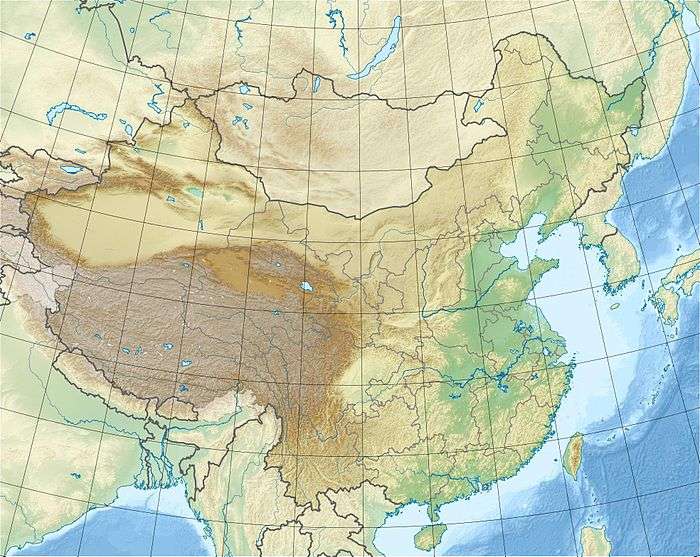Tuchengzi Formation
The Tuchengzi Formation (simplified Chinese: 土城子组; traditional Chinese: 土城子組; pinyin: Tǔchéngzǐ Zǔ) is a geological formation in China whose strata span the Tithonian (Late Jurassic) to Berriasian (Early Cretaceous) ages.[1] Dinosaur fossils, particularly footprints, have been found from the formation.[3][4]
| Tuchengzi Formation Stratigraphic range: Tithonian-Berriasian ~154–139 Ma [1] | |
|---|---|
| Type | Geological formation |
| Underlies | Zhangjiakou Formation |
| Overlies | Tiaojishan Formation |
| Thickness | 870–2,900 metres (2,850–9,510 ft)[2] |
| Lithology | |
| Primary | Shale |
| Other | Sandstone, mudstone |
| Location | |
| Coordinates | 42.9°N 124.0°E |
| Approximate paleocoordinates | 44.1°N 126.1°E |
| Region | Beijing, Hebei, Liaoning |
| Country | |
 Tuchengzi Formation (China)  Tuchengzi Formation (Liaoning) | |
Vertebrate paleofauna
The Tuchengzi Formation was deposited during a time of transition between the Daohugou Biota and the Jehol biota. The Tuchengzi represents a poorer, more arid climate that appears to have caused much of the Daohugou fauna to become extinct. They would later be replaced by the Jehol biota when conditions became more favorable to a diversity of terrestrial animal life.[1]
Indeterminate sauropod remains formerly attributed to the Mamenchisauridae and Brachiosauridae have been found in Liaoning, China.[3] Theropod tracks, including those made by avialans, have been found in Liaoning, China.[3]
| Genus | Species | County | Member | Abundance | Notes | Image |
|---|---|---|---|---|---|---|
| Orientognathus | ||||||
| Chaoyangsaurus | C. youngi | Liaoning | "Partial skull with mandible, cervicals, humerus, and scapula."[5]
A primitive ceratopsian[3] |
|||
|
Grallator isp. |
Footprints belonging to the Grallator form taxon, made by an unknown small theropod.[6] |
|||||
|
Menglongipus |
M. sinensis |
Hebei |
Footprints belonging to the Menglongipus sinensis form taxon, made by an unknown small (~65 cm long) deinonychosaur[6] |
|||
Color key
|
Notes Uncertain or tentative taxa are in small text; |
See also
- List of dinosaur-bearing rock formations
References
- Liu Y.-Q. Kuang H.-W., Jiang X.-J., Peng N., Xu H. & Sun H.-Y. (2012). "Timing of the earliest known feathered dinosaurs and transitional pterosaurs older than the Jehol Biota." Palaeogeography, Palaeoclimatology, Palaeoecology (advance online publication).
- Wang, Y.; Ken, S.; Zhang, W.; Zheng, S. (2006). "Biodiversity and palaeoclimate of the Middle Jurassic floras from the Tiaojishan Formation in western Liaoning, China". Progress in Natural Science. 16 (1): 222–230. doi:10.1080/10020070612330087.
- Weishampel, David B; et al. (2004). "Dinosaur distribution (Late Jurassic, Asia)." In: Weishampel, David B.; Dodson, Peter; and Osmólska, Halszka (eds.): The Dinosauria, 2nd, Berkeley: University of California Press. Pp. 550–552. ISBN 0-520-24209-2.
- Xing, Lida; Lockley, Martin G.; Du, Tianming; Zhang, Lijun; Klein, Hendrik; Romilio, Anthony; Persons, W. Scott; Wang, Kuan; Li, Zhenyu; Wan, Xiaoqiao (March 2020). "Dinosaur tracks from the Jurassic-Cretaceous boundary Tuchengzi Formation (Hebei Province, China) used as building stones in the Chengde imperial summer resort: Age, ichnology, and history". Cretaceous Research. 107: 104310. doi:10.1016/j.cretres.2019.104310.
- "Table 22.1," in Weishampel, et al. (2004). Page 480.
- Xing, L.; Harris, J.D.; Sun, D.; Zhao, H. (2010). "The earliest known deinonychosaur tracks from the Jurassic-Cretaceous boundary in Hebei Province, China". Acta Palaeontologica Sinica. 48 (4): 662–671.